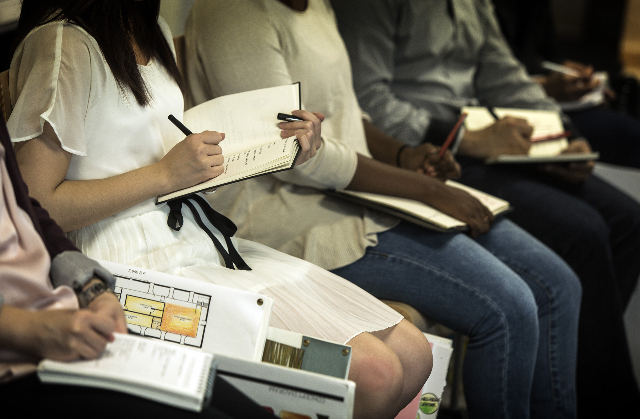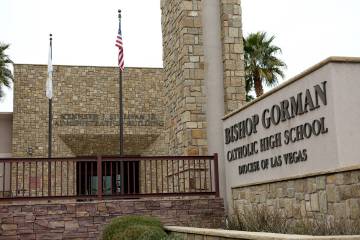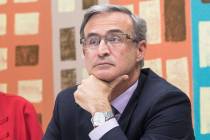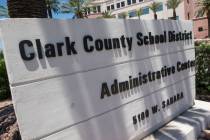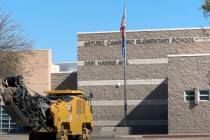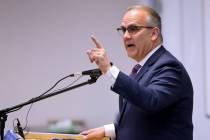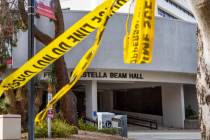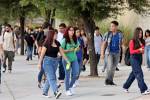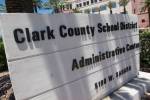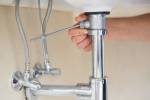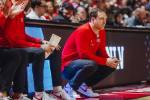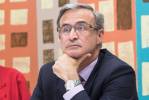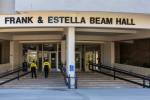UNLV rebounding after post-recession enrollment slump
Caught in the grip of the nation's economic decline, the University of Nevada, Las Vegas has struggled for the past four years to recover from a plunge in student attendance.
"We were just devastated in all aspects by the recession: We had no recruiting capabilities and many students couldn't afford to go to school anymore," UNLV Senior Vice Provost Carl Reiber said. "We're still not where we were before in terms of our support structure, but we've been working smarter and more efficiently as a post-recession UNLV."
Enrollment at the campus tumbled by 6 percent between 2009 and 2011 — its biggest decline since 1962. But aided by a stabilizing economy and a boost in recruitment resources, attendance has inched back up, with administrators anticipating near-peak levels of about 29,000 for fall 2015.
A spike, a slump
UNLV hasn't struggled alone — attendance levels at colleges and universities across the country have endured a dizzying yo-yo effect because of the recent economic downturn..
First, enrollment spiked as people who were struggling to find work sought instead to advance their education. Then as the economy improved, attendance rates nose dived — a trend seen at Southern Nevada's two primary higher education institutions.
UNLV, which had enjoyed largely uninterrupted growth since the mid-1990s, experienced a boost in attendance of about 4 percent between 2008 and 2009 before rates slipped by 6 percent over the next two years. At the College of Southern Nevada, enrollment jumped 12 percent between 2007 and 2010, peaking at 44,000 before plunging 17 percent over the next four years.
"College enrollment trends tend to be counter-cyclical in terms of employment," said Dewayne Matthews, vice president of strategy for the Indianapolis-based education nonprofit Lumina Foundation. "When employment rates are low, enrollment goes up, and when employment rates are up, enrollment goes down."
The enrollment drop may seem like good news for Southern Nevada's workforce. But in Las Vegas — a hard-hit city that is still grappling with the recession's lingering aftermath — the drop in attendance was also the result of students' inability to keep up with tuition hikes prompted by state budget cuts.
This semester, for instance, UNLV implemented a four-year plan to raise undergraduate tuition by 17 percent. Nevada education officials who approved the plan said the higher fees would help offset state budget cuts that led to a 22 percent decline in higher education funding between 2009 and 2014. That funding drop was the third-largest nationally, according to research conducted by the education school at Illinois State University.
At least one campus in the Las Vegas Valley managed to buck the national trend: Nevada State College, a 13-year-old school in the foothills of the Henderson desert, reported only small head count drops in 2008 and in 2013. Enrollment there has ballooned from 176 students in 2002 to 3,549 in 2014.
Low graduation rates
Many of those who flocked to college when the economy soured sought majors that they perceived as economically viable, said Brian Cadena, an economics professor at the University of Colorado, Boulder who studied the trend using data from the U.S. Census Bureau.
At UNLV, those seemed to include fields within the hospitality, engineering and business departments, Reiber said.
"In general, majors that tend to have lower unemployment rates attracted more people during the recession," Cadena said. "It's pretty symmetric — when the employment rate goes back up, people shift back away from these majors and lean toward liberal arts fields."
While the initial jump in enrollment may have appeared to be a boon for colleges and universities, it didn't necessarily lead to higher graduation rates nationwide, according to the National Student Clearinghouse Research Center.
A study conducted by the nonprofit found that the number of incoming students grew that year by 12 percent, but only about 55 percent of them earned a degree or certificate within six years, compared with 56.1 percent of those who enrolled in 2007 and earned a degree.
Emergence
Intent on raising attendance levels, UNLV and CSN officials have amped up and retooled their recruitment efforts in recent years.
UNLV, whose student affairs budget was slashed by 13 percent during the recession, has begun to allocate more resources to enlisting new students. The school hired three new recruiters this year tasked with seeking applicants in central California.
Administrators say they have focused on enlisting high-performing recruits: The first-year class for its honors college has quadrupled over the past four years, bringing its current student count to 700. And the school welcomed 60 high school valedictorians to its incoming class this semester.
Unable to raise its recruitment budget, CSN is taking a different approach. The community college has refocused its target pool by concentrating on Clark County schools that draw the most CSN applicants. It's also strengthening efforts to attract underserved populations, seeking more high school dropouts in Southern Nevada to participate in CSN's high school equivalency programs with the hope that they will pursue an associate degree.
"You have to consider that we're in a highly competitive market," said Hyla Winters, CSN's interim vice president for academic affairs. "In the old days, you could just sit here and let students come. Now, we have to be more strategic so we can prepare ourselves (for) highs and lows as the economy waxes and wanes."
Contact Ana Ley at aley@reviewjournal.com or 702-224-5512. Find her on Twitter @la__ley



